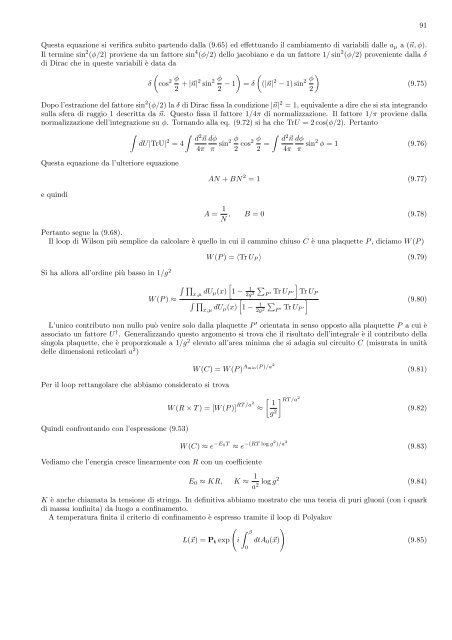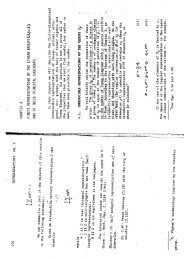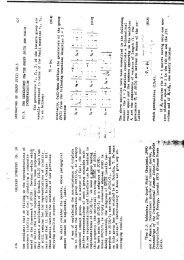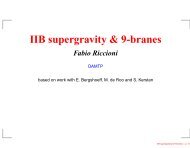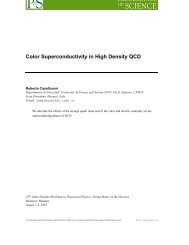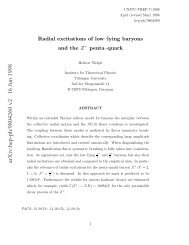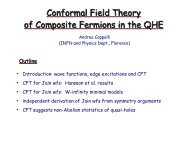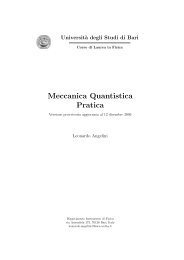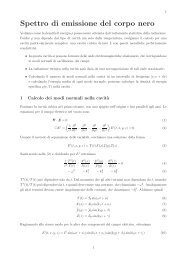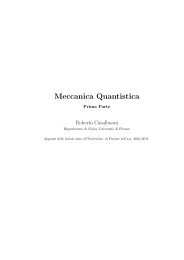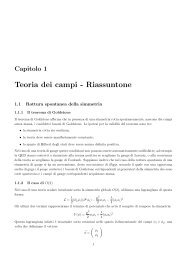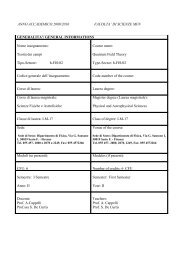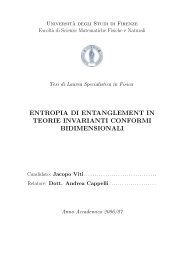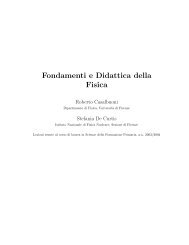Appunti per il corso: Fisica del plasma di quark e gluoni (A.A. ... - Infn
Appunti per il corso: Fisica del plasma di quark e gluoni (A.A. ... - Infn
Appunti per il corso: Fisica del plasma di quark e gluoni (A.A. ... - Infn
Create successful ePaper yourself
Turn your PDF publications into a flip-book with our unique Google optimized e-Paper software.
Questa equazione si verifica subito partendo dalla (9.65) ed effettuando <strong>il</strong> cambiamento <strong>di</strong> variab<strong>il</strong>i dalle aµ a (n, φ).<br />
Il termine sin 2 (φ/2) proviene da un fattore sin 4 (φ/2) <strong>del</strong>lo jacobiano e da un fattore 1/ sin 2 (φ/2) proveniente dalla δ<br />
<strong>di</strong> Dirac che in queste variab<strong>il</strong>i è data da<br />
δ<br />
<br />
2 φ<br />
cos<br />
2 + |n|2 <br />
2 φ<br />
sin − 1<br />
2<br />
<br />
= δ (|n| 2 − 1) sin<br />
<br />
2 φ<br />
2<br />
Dopo l’estrazione <strong>del</strong> fattore sin 2 (φ/2) la δ <strong>di</strong> Dirac fissa la con<strong>di</strong>zione |n| 2 = 1, equivalente a <strong>di</strong>re che si sta integrando<br />
sulla sfera <strong>di</strong> raggio 1 descritta da n. Questo fissa <strong>il</strong> fattore 1/4π <strong>di</strong> normalizzazione. Il fattore 1/π proviene dalla<br />
normalizzazione <strong>del</strong>l’integrazione su φ. Tornando alla eq. (9.72) si ha che TrU = 2 cos(φ/2). Pertanto<br />
<br />
dU|TrU| 2 = 4<br />
Questa equazione da l’ulteriore equazione<br />
e quin<strong>di</strong><br />
2 d n dφ φ φ<br />
sin2 cos2<br />
4π π 2 2 =<br />
91<br />
(9.75)<br />
2 d n dφ<br />
4π π sin2 φ = 1 (9.76)<br />
AN + BN 2 = 1 (9.77)<br />
A = 1<br />
, B = 0 (9.78)<br />
N<br />
Pertanto segue la (9.68).<br />
Il loop <strong>di</strong> W<strong>il</strong>son più semplice da calcolare è quello in cui <strong>il</strong> cammino chiuso C è una plaquette P , <strong>di</strong>ciamo W (P )<br />
Si ha allora all’or<strong>di</strong>ne più basso in 1/g 2<br />
W (P ) ≈<br />
<br />
x,µ dUµ(x)<br />
<br />
W (P ) = 〈Tr UP 〉 (9.79)<br />
<br />
x,µ dUµ(x)<br />
1 − 1<br />
2g 2<br />
<br />
1 − 1<br />
2g 2<br />
<br />
P ′ Tr UP ′<br />
<br />
P ′ Tr UP ′<br />
Tr UP<br />
(9.80)<br />
L’unico contributo non nullo può venire solo dalla plaquette P ′ orientata in senso opposto alla plaquette P a cui è<br />
associato un fattore U † . Generalizzando questo argomento si trova che <strong>il</strong> risultato <strong>del</strong>l’integrale è <strong>il</strong> contributo <strong>del</strong>la<br />
singola plaquette, che è proporzionale a 1/g 2 elevato all’area minima che si adagia sul circuito C (misurata in unità<br />
<strong>del</strong>le <strong>di</strong>mensioni reticolari a 2 )<br />
Per <strong>il</strong> loop rettangolare che abbiamo considerato si trova<br />
Quin<strong>di</strong> confrontando con l’espressione (9.53)<br />
W (C) = W (P ) Amin(P )/a 2<br />
W (R × T ) = [W (P )] RT/a2<br />
≈<br />
<br />
1<br />
g2 2<br />
RT/a<br />
W (C) ≈ e −E0T ≈ e −(RT log g 2 )/a 2<br />
Ve<strong>di</strong>amo che l’energia cresce linearmente con R con un coefficiente<br />
E0 ≈ KR, K ≈ 1<br />
log g2<br />
a2 K è anche chiamata la tensione <strong>di</strong> stringa. In definitiva abbiamo mostrato che una teoria <strong>di</strong> puri <strong>gluoni</strong> (con i <strong>quark</strong><br />
<strong>di</strong> massa ionfinita) da luogo a confinamento.<br />
A tem<strong>per</strong>atura finita <strong>il</strong> criterio <strong>di</strong> confinamento è espresso tramite <strong>il</strong> loop <strong>di</strong> Polyakov<br />
<br />
<br />
L(x) = Pt exp<br />
i<br />
β<br />
0<br />
dtA0(x)<br />
(9.81)<br />
(9.82)<br />
(9.83)<br />
(9.84)<br />
(9.85)


